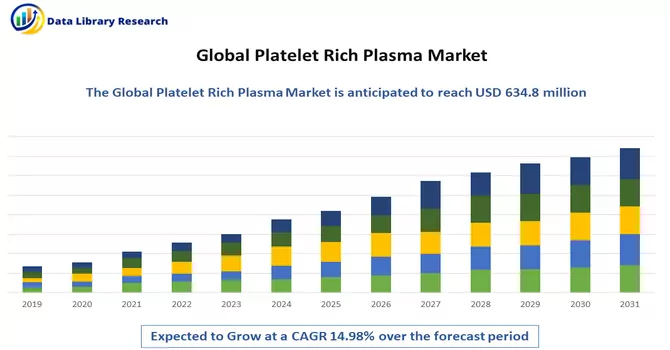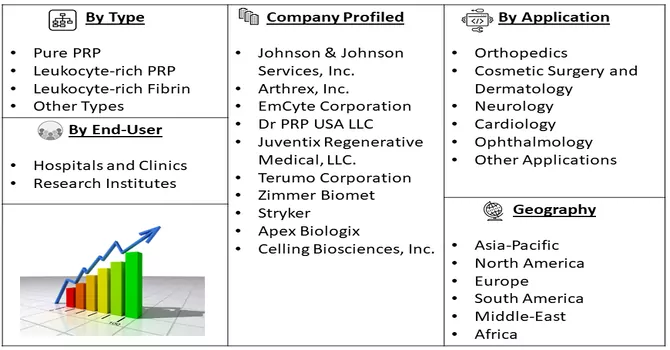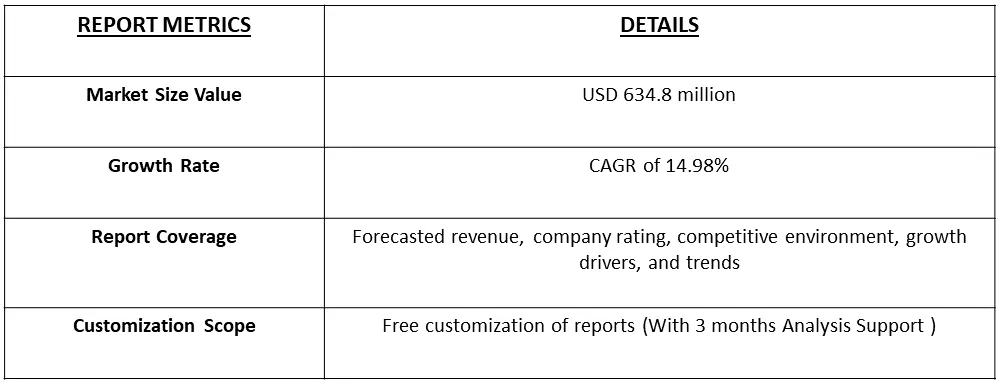The global platelet rich plasma (PRP) market size was valued at USD 634.8 million in 2023 and is expected to grow at a compound annual growth rate (CAGR) of 14.98% from 2024 to 2031.

Get Complete Analysis Of The Report - Download Free Sample PDF
Platelet-rich plasma (PRP) market is driven by several factors contributing to its growth and widespread adoption. Firstly, the increasing prevalence of orthopedic and sports injuries has fueled the demand for PRP therapies, as it is recognized for its regenerative properties and ability to accelerate tissue healing. Secondly, the expanding applications of PRP across diverse medical fields, including dermatology, dentistry, and aesthetic medicine, contribute to its market growth. Additionally, the aging population and a growing awareness of minimally invasive procedures have led to a rise in cosmetic and reconstructive surgeries, where PRP is often utilized. The continuous advancements in medical technology and the development of PRP preparation systems also play a pivotal role in driving market expansion. Furthermore, the focus on research and clinical studies validating the efficacy of PRP treatments enhances its credibility, fostering acceptance among healthcare professionals. Lastly, the increasing collaboration between industry players and healthcare providers for the development and commercialization of PRP products contributes to market growth by ensuring a wider reach and availability of these therapies.
The utilization of platelet-rich plasma (PRP) is on the rise, driven by a surge in sports-related injuries due to increased participation in sporting events and a growing demand for cosmetic surgery. The expanding research applications of PRP also contribute to the growth of the industry. Notably, the American Society of Plastic Surgeons reported a 25% increase in the use of PRP in cosmetic procedures over the past four years as of 2020. However, the global market has been significantly impacted by the COVID-19 pandemic, with governments worldwide implementing protective measures and restrictions in response to the outbreak, leading to notable disruptions across various industries, including PRP.
Platelet-rich plasma (PRP) market trends indicate a growing adoption of PRP therapies driven by increasing awareness and acceptance across various medical fields. The rise in sports-related injuries and the demand for regenerative treatments contribute to the expansion of PRP applications, particularly in orthopedics and sports medicine. Cosmetic and aesthetic procedures incorporating PRP, such as facial rejuvenation and hair restoration, are witnessing a notable upswing in demand. Continuous advancements in PRP preparation technologies and the development of specialized medical devices enhance the efficiency and accessibility of these therapies. Moreover, research initiatives exploring new applications and refining existing protocols contribute to the evolving landscape of PRP usage. The market is also influenced by collaborations between industry players and healthcare providers, aiming to leverage synergies for product development and commercialization. Despite the impact of the COVID-19 pandemic, the PRP market exhibits resilience, adapting to changing healthcare dynamics and maintaining growth momentum.
Market Segmentation: The Market Report Covers Global Platelet Rich Plasma Therapy Companies and is Segmented by Type (Pure PRP, Leukocyte-rich PRP, Leukocyte-rich Fibrin, and Other Types), Application (Orthopedics, Cosmetic Surgery and Dermatology, Neurology, Cardiology, Ophthalmology, and Other Applications), End User (Hospitals and Clinics and Research Institutes), and Geography (North America, Europe, Asia-Pacific, Middle East & Africa, and South America). The value is provided in (USD million) for the above segments.

For Detailed Market Segmentation - Download Free Sample PDF
Market Drivers:
Increasing cases of sports injuries and upsurge in cosmetic surgery.
The rise in sports injuries and the surge in cosmetic surgery procedures are prominent trends reflecting the evolving landscape of healthcare and aesthetic preferences. The increasing participation in sports has led to a parallel uptick in sports-related injuries, necessitating advanced and effective treatment modalities. Platelet-Rich Plasma (PRP) therapies have emerged as a valuable option for athletes, leveraging the regenerative properties of platelets to accelerate tissue healing and promote recovery. Concurrently, there has been a notable upsurge in cosmetic surgery procedures driven by changing societal norms and an emphasis on personal aesthetics. Individuals seeking enhancements and rejuvenation turn to cosmetic surgeries for procedures ranging from facelifts and rhinoplasty to non-invasive treatments like injectables and laser therapies. PRP has found a significant role in the realm of cosmetic surgery, being integrated into procedures to optimize outcomes, particularly in areas such as facial rejuvenation and hair restoration. The dual trends of increasing sports injuries and a growing inclination towards cosmetic procedures have spurred innovation and advancements in medical technologies. PRP, with its applications in both sports medicine and cosmetic surgery, exemplifies a versatile solution catering to the diverse needs of individuals seeking effective, minimally invasive treatments. This confluence of trends underscores the dynamic intersection between sports medicine and aesthetics, with PRP playing a pivotal role in addressing the unique demands of these evolving healthcare landscapes.
Increasing research applications of platelet rich plasma (PRP)
The research applications of Platelet-Rich Plasma (PRP) are expanding across diverse medical fields, with ongoing investigations beyond its established uses in orthopedics and sports medicine. In dermatology, PRP is being studied for its effectiveness in skin rejuvenation and scar revision, showcasing its potential in aesthetic applications. Dentistry research explores PRP's role in oral and maxillofacial surgery, implantology, and periodontics, aiming to enhance outcomes in various dental procedures. Additionally, PRP research extends to cardiovascular medicine, neurology, and wound healing, indicating a broadening recognition of its regenerative properties. The collaborative efforts of researchers, clinicians, and industry experts are shaping PRP's trajectory as a versatile therapeutic tool with promising applications across a spectrum of medical specialties.
Market Restraints:
High Cost of PRP
The high cost associated with Platelet-Rich Plasma (PRP) treatments poses a potential challenge to the widespread adoption and growth of this regenerative therapy. Despite its proven efficacy in various medical and cosmetic applications, the expense involved in the preparation, processing, and administration of PRP may limit accessibility for a broader demographic. This financial barrier could impact patient acceptance and the willingness of healthcare providers to incorporate PRP into routine medical practices. Addressing the cost concerns associated with PRP, through technological advancements, streamlined processes, or insurance coverage, will likely be instrumental in ensuring the continued expansion and acceptance of this promising therapeutic modality. Efforts to make PRP more economically viable could play a crucial role in overcoming financial constraints and facilitating its integration into mainstream medical treatments.
The ongoing COVID-19 pandemic has played a pivotal role in the market expansion of platelet-rich plasma (PRP) due to the absence of specific antiviral therapies. PRP, categorized as an emergency treatment method, gained prominence as a valuable option. An notable advantage of PRP is its application in pain relief during the COVID-19 crisis. This technique, initially employed to circumvent surgery, has proven effective in offering short-term pain relief for patients awaiting clearance for surgical intervention. Importantly, it provides an alternative for those reluctant to face potential delays caused by the adverse effects of steroids. The adaptability of PRP in managing pain and its relevance in emergency situations contribute to its increased adoption and market growth during the challenging circumstances presented by the pandemic.
Segmental Analysis:
Leukocyte-rich PRP Segment is Expected to Witness Significant Growth Over the Forecast Period
Leukocyte-rich Platelet-Rich Plasma (LR-PRP) is a specialized form of PRP that contains a higher concentration of white blood cells, or leukocytes. In traditional PRP preparations, the focus is primarily on platelets and their growth factors for tissue regeneration. However, LR-PRP includes a significant presence of leukocytes, which are immune cells with various functions. The inclusion of leukocytes in LR-PRP is believed to have potential benefits, particularly in enhancing the anti-inflammatory and immune-modulating properties of the treatment. The leukocytes contribute to the body's defense mechanisms, and their presence in LR-PRP may play a role in regulating inflammation and promoting healing in certain conditions. While standard PRP is often used in musculoskeletal and orthopedic applications, LR-PRP has found applications in a broader range of medical fields, including wound healing, dermatology, and chronic inflammatory conditions. The specific composition of LR-PRP may vary based on the preparation method and the intended therapeutic use.Research and clinical studies continue to explore the efficacy of LR-PRP in comparison to traditional PRP formulations, aiming to better understand its impact on various medical conditions. The utilization of LR-PRP represents a nuanced approach within the broader landscape of platelet-rich plasma therapies, with ongoing advancements contributing to its evolving role in regenerative medicine.
Cosmetic Surgery Segment is Expected to Witness Significant Growth Over the Forecast Period
The integration of Platelet-Rich Plasma (PRP) into the field of cosmetic procedures has revolutionized aesthetic treatments, offering natural and rejuvenating benefits. Cosmetic applications of PRP involve harnessing the regenerative properties of platelets and growth factors derived from the patient's own blood to enhance various procedures. Facial rejuvenation is a prominent area where PRP has made a significant impact. Often used in combination with treatments such as microneedling and dermal fillers, PRP contributes to improved skin texture, increased collagen production, and a more youthful appearance. The growth factors present in PRP stimulate cell regeneration, helping reduce fine lines, wrinkles, and other signs of aging. Hair restoration is another key focus of PRP in the cosmetic realm. Injecting PRP into the scalp has shown promise in promoting hair growth, increasing hair thickness, and addressing certain types of hair loss. This non-surgical approach is increasingly sought after by individuals looking for effective solutions to hair-related concerns. PRP is also utilized in scar revision and skin pigmentation treatments. The regenerative qualities of PRP support tissue healing, making it a valuable adjunct in minimizing the appearance of scars and improving overall skin tone.
Clinics and Research Institutes Segment is Expected to Witness Significant Growth Over the Forecast Period
Clinics and research institutions play a pivotal role in advancing the understanding and application of Platelet-Rich Plasma (PRP) in various medical fields. PRP, derived from the patient's own blood, contains concentrated platelets and growth factors that have shown promising regenerative properties. Clinics serve as essential hubs where PRP is administered for a range of therapeutic purposes, while research endeavors contribute to refining protocols and expanding the scope of its applications. In clinics, PRP is commonly utilized in orthopedics for the treatment of musculoskeletal injuries and joint disorders. The regenerative capabilities of PRP promote tissue healing and may help accelerate recovery in conditions such as tendonitis, osteoarthritis, and ligament injuries. Dermatology clinics also employ PRP for aesthetic purposes, including facial rejuvenation, scar revision, and hair restoration, showcasing its versatility in addressing various medical and cosmetic concerns. Research initiatives focused on PRP aim to enhance our understanding of its mechanisms and effectiveness across different medical disciplines. Studies explore novel applications, optimal preparation methods, and the long-term outcomes of PRP treatments. This research contributes to evidence-based practices, guiding clinicians in delivering more effective and tailored PRP therapies. The collaboration between clinics and research entities is crucial for driving innovation in PRP applications. Clinicians often participate in or support research studies to gather real-world data and refine treatment protocols based on clinical outcomes. This iterative process fosters a feedback loop between the laboratory and the clinic, ensuring that PRP therapies evolve with the latest scientific insights and clinical experiences.
North America Region is Expected to Witness Significant Growth Over the Forecast Period
In North America, Platelet-Rich Plasma (PRP) has gained prominence as a versatile therapeutic approach, finding widespread applications in orthopedics, sports medicine, and aesthetic practices. The region, led by the United States and Canada, demonstrates a robust integration of PRP in clinical settings and cosmetic procedures. PRP's regenerative properties have made it a preferred option for musculoskeletal conditions, ranging from sports injuries to osteoarthritis. Simultaneously, dermatology and cosmetic surgery clinics leverage PRP for facial rejuvenation, scar revision, and hair restoration, aligning with the region's emphasis on cutting-edge aesthetic solutions. The collaborative efforts between clinics and research institutions contribute to ongoing advancements in PRP technology, positioning North America as a dynamic hub for the evolving landscape of regenerative medicine.

Get Complete Analysis Of The Report - Download Free Sample PDF
The market exhibits a moderate level of competitiveness characterized by the presence of a select few key players. These prominent industry participants play a significant role in shaping the dynamics of the market, contributing to its overall stability and evolution. The competitive landscape is marked by a balance between established entities, each vying for market share and influence. This moderate competitive scenario encourages innovation, strategic collaborations, and continuous improvements among the key players as they navigate the market dynamics to maintain their positions and explore new opportunities for growth. Some of the prominent key players in the global platelet rich plasma (PRP) market include:
Recent Development:
1) In May 2023, Dr. John Kahen, the creator of Beverly Hills Med Spa, was granted a U.S. patent for Smart PRP therapy. This innovative technique is primarily employed in hair restoration and extends its applications to include skin rejuvenation, addressing issues like scarring, pigmentation, and texture improvement.
2) In February 2021, Atlas Health Medical Group introduced Platelet-rich Plasma (PRP) Microneedling Facelifts as part of their offerings for patients.
Q1. What was the Platelet Rich Plasma Market size in 2023?
As per Data Library Research the global platelet rich plasma (PRP) market size was valued at USD 634.8 million in 2023.
Q2. At what CAGR is the Platelet Rich Plasma market projected to grow within the forecast period?
Platelet Rich Plasma Market is expected to grow at a compound annual growth rate (CAGR) of 14.98% over the forecast period.
Q3. What are the factors driving the Platelet Rich Plasma market?
Key factors that are driving the growth include the Increasing cases of sports injuries and upsurge in cosmetic surgery and Increasing research applications of platelet rich plasma (PRP).
Q4. What segments are covered in the Platelet Rich Plasma market Report?
By Type, By Application, By Ens-User and Gepgraphy these are the segments are covered in the Platelet Rich Plasma market Report.
Data Library Research are conducted by industry experts who offer insight on industry structure, market segmentations technology assessment and competitive landscape (CL), and penetration, as well as on emerging trends. Their analysis is based on primary interviews (~ 80%) and secondary research (~ 20%) as well as years of professional expertise in their respective industries. Adding to this, by analysing historical trends and current market positions, our analysts predict where the market will be headed for the next five years. Furthermore, the varying trends of segment & categories geographically presented are also studied and the estimated based on the primary & secondary research.
In this particular report from the supply side Data Library Research has conducted primary surveys (interviews) with the key level executives (VP, CEO’s, Marketing Director, Business Development Manager and SOFT) of the companies that active & prominent as well as the midsized organization
FIGURE 1: DLR RESEARH PROCESS

Extensive primary research was conducted to gain a deeper insight of the market and industry performance. The analysis is based on both primary and secondary research as well as years of professional expertise in the respective industries.
In addition to analysing current and historical trends, our analysts predict where the market is headed over the next five years.
It varies by segment for these categories geographically presented in the list of market tables. Speaking about this particular report we have conducted primary surveys (interviews) with the key level executives (VP, CEO’s, Marketing Director, Business Development Manager and many more) of the major players active in the market.
Secondary ResearchSecondary research was mainly used to collect and identify information useful for the extensive, technical, market-oriented, and Friend’s study of the Global Extra Neutral Alcohol. It was also used to obtain key information about major players, market classification and segmentation according to the industry trends, geographical markets, and developments related to the market and technology perspectives. For this study, analysts have gathered information from various credible sources, such as annual reports, sec filings, journals, white papers, SOFT presentations, and company web sites.
Market Size EstimationBoth, top-down and bottom-up approaches were used to estimate and validate the size of the Global market and to estimate the size of various other dependent submarkets in the overall Extra Neutral Alcohol. The key players in the market were identified through secondary research and their market contributions in the respective geographies were determined through primary and secondary research.
Forecast Model
